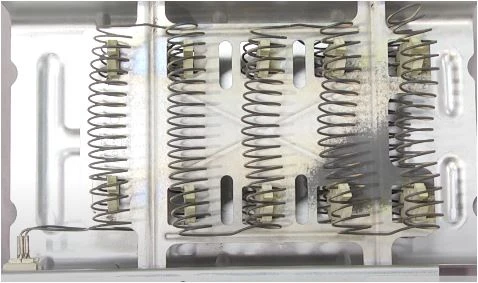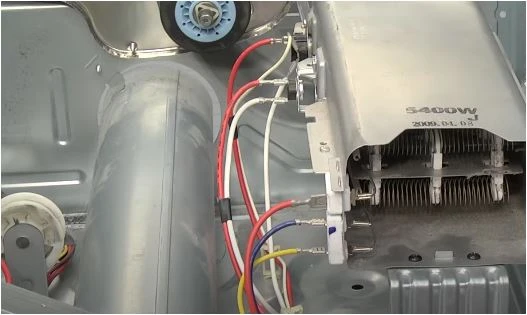| Note: This article may contain affiliate links, which means if you make a purchase following our links won’t cost you extra, but we may earn a commission. Learn more |
Oh, encountering a dryer that’s hot to the touch even when it’s not running can be alarming. This is not typical behavior for dryers and might signify some underlying issues.
A dryer feeling warm, especially on its sides, may be an indication of several issues. One of the primary reasons can be a malfunctioning heating element. This component is responsible for warming the air that dries the clothes.
If it doesn’t shut off correctly, it can cause the appliance to overheat, even on a low setting. Such overheating might be the reason for wrinkled clothes, as the excess heat can cause fabrics to lose their shape.
While it’s natural for the vent to release hot air, the exterior of the appliance should remain relatively cool. If the side of the dryer is hot, it can suggest problems with ventilation or a faulty timer that doesn’t switch the machine off when it should. In worst-case scenarios, continuous overheating might lead the device to shut off as a safety measure.
If you suspect your dryer is too hot, consulting a professional for a diagnosis is advised. They can provide guidance on whether there are potential risks and recommend solutions to rectify the situation. Regular maintenance can also prevent such issues in the future.
5 Reasons Dryers Hot to Touch When Not Running & Their Solutions
Dryers are essential household appliances, but it can be concerning if one becomes hot to the touch, especially when not running. Several reasons could be behind this, and understanding them can help you address the issue.
1. Malfunctioning Heating Element

The heating element is responsible for warming up the air that circulates inside the dryer to dry your clothes. If it fails to shut off after the drying cycle or operates unpredictably, the dryer can remain hot long after use.
Solution: Turn off and unplug the dryer. Check for any visible damages. If you’re comfortable, you can open the back panel and inspect the heating element. It may need replacement or repair, which is best done by a professional.
2. Faulty Timer Mechanism
The timer controls the duration of each drying cycle. If it malfunctions, the dryer might continue to produce heat even after the cycle ends.
Solution: Ensure that the timer is set correctly and is moving as it should during the drying cycle. If not, you may need to replace the timer mechanism.
3. Blocked Ventilation
Proper ventilation ensures that the hot air from the dryer is expelled outside. If the vent is clogged or blocked, the heat might build up, causing the exterior to become hot.
Solution: Regularly clean the lint filter and check the external vent for any blockages. Ensure that the vent hose isn’t kinked or bent in a way that restricts airflow.
4. Thermostat Issues
The thermostat regulates the temperature inside the dryer. A faulty thermostat might not regulate the heat properly, causing overheating.
Solution: Check the thermostat for damages or irregularities. If it appears to be malfunctioning, consider replacing it.
5. Overloading the Dryer
Adding too many clothes can strain the machine, causing it to overheat.
Solution: Always follow the manufacturer’s guidelines on load sizes. Make sure not to stuff the dryer, allowing clothes to tumble freely.
If problems persist after troubleshooting, seeking advice from a professional technician is recommended. Regular maintenance and periodic checks can also prevent such issues from arising.
Dryer Hot to Touch: Other Related Problems
Dryer Exterior Warmth
Is it common for the outer surface of your dryer to feel warm? A slight warmth can be expected, especially after a cycle. However, excessive heat on the dryer’s exterior indicates an issue. It can arise from a malfunctioning heating element, which doesn’t turn off after a cycle.
Another reason might be a blocked vent that traps heat inside, causing the exterior to get excessively hot. Regular checks of the ventilation system and periodic maintenance can reduce such occurrences.
Recognizing Overheating Issues
Overheating in a dryer is not only a functional problem but can also pose safety risks. There are clear signs that your dryer might be overheating.

1. Clothes come out extremely hot after a cycle.
2. A burning smell emanates from the dryer.
3. The dryer stops mid-cycle without completing the drying process.
Addressing these signs early can prevent potential fires. Cleaning the lint filter regularly and ensuring proper ventilation are essential steps to combat this problem.
Wrinkles Due to Overheating
If your clothes are coming out of the dryer with more wrinkles than usual, it might be due to excessive heat.
Overheating can cause fabrics to lose moisture rapidly, leading to wrinkles. One can resolve this by ensuring the dryer is set to the right temperature and not overloading it.
Too Warm on Low
A dryer that gets excessively hot even on a low setting is a clear indicator of malfunction. This can be due to a faulty thermostat that’s unable to regulate the temperature correctly. Checking and possibly replacing the thermostat can resolve this issue.
Shutdowns From Overheating
A dryer that overheats and subsequently shuts off is implementing its safety measures. This auto-shutoff is a feature in most modern dryers to prevent potential hazards.
This situation may arise due to blockages in the ventilation system, a malfunctioning heating element, or a faulty thermostat. Regularly inspecting these components and seeking professional help if unsure is the best course of action.
Learn More: Gas Dryer Igniter Glows But No Flame: Identifying & Resolving Issues